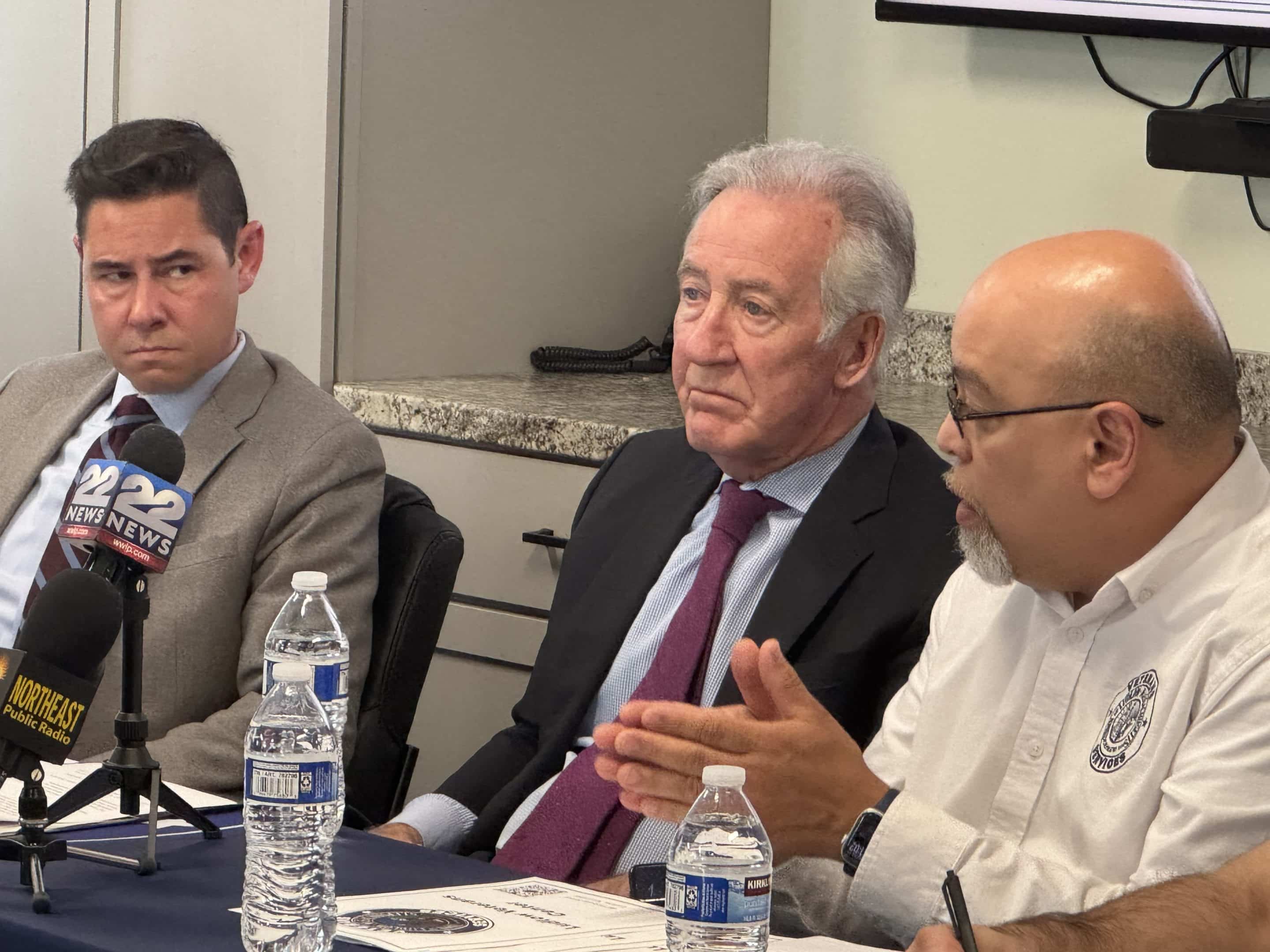Ludlow Director of Veterans’ Services Eric Segundo (right) speaks to U.S. Rep. Richard Neal (center) and state Sen. Jake Oliveira (left) on what he and his team are thinking at the local level as they face potential impacts to VA services due to federal cuts.
Reminder Publishing photos by Trent Levakis
LUDLOW — U.S. Rep Richard Neal visited the Ludlow Veterans Center on April 22 to meet with veterans and join a roundtable discussion of policies and actions taken by the Trump administration and the impact on local veterans.
The Springfield Democrat joined Ludlow Director of Veterans’ Services Eric Segundo, state Sen. Jake Oliveira (D-Ludlow) and other officials working in veteran services across Western Mass.
The roundtable discussion focused on how during its first 100 days, several actions by the Trump administration have undermined the U.S. Department of Veterans Affairs’ mission of serving the nation’s veterans. On Jan. 20, the president signed a memorandum ordering all teleworking and remote work federal employees to return to the office.
In implementing this directive, the VA rescinded telework and remote work agreements for about 20% of its 482,000 employees, including those who staff the Veterans Crisis Line. It wasn’t until March 7 that crisis line workers were informed of their exemption from the return-to-office requirements.
On March 4, a memo was circulated amongst officials at the VA calling for 83,000 staff members to be cut. With veterans accounting for 30% of the federal workforce, these cuts will not only impact the VA’s services, but also cost veterans their employment.
To date, the VA has already cut 2,400 employees, including Mike Slater, a U.S. Army veteran who completed four tours in Iraq and Afghanistan. Slater was terminated from his employment with the Springfield Veterans Center in February and was Neal’s guest at President Donald Trump’s address to Congress.
“It’s important to consider where we were just a few months ago. Under [former President Joe Biden’s] administration, veterans saw the largest investment in veterans’ services in three decades with the enactment of the PACT Act. Those are earned benefits that are now being jeopardized to finance a tax cut for the wealthy,” said Neal. “How anyone can look a veteran in the eye and say these cuts won’t impact their services is not only a denial of both reality and responsibility, but a shameful attempt to mislead those who have honorably served our country. That is why I am here today, to listen to our veterans and hear directly from them about how these cuts will impact their day-to-day lives.”
Neal’s office claims the administration’s cuts to the VA workforce will also impact veterans’ healthcare as the Veterans Health Administration workforce accounts for 90% of the VA’s 482,000 workers, meaning any cuts to the VA’s workforce will mean cuts to healthcare. This would come after the VA enrolled 400,000 veterans in its benefits system from March 2023 through March 2024, 30% more than the prior year.
In addition, a 2024 report by the Office of the Inspector General found that 137 of 139 VA health centers nationwide report a severe staffing shortage in at least one area, particularly nursing and psychology. These staff shortages, Neal asserted, have led to long wait times for the more than 9 million veterans the VA serves.
“When our service members enter the service, we make them a promise: you protect us, and we’ll take care of you. The VA is central to the obligation we have of fulfilling that promise, and you don’t accomplish that by gutting the department’s workforce,” Neal added. “This is more of the same of what we’ve seen from this administration — chaotic and reckless decision making that has a real impact on everyday Americans. I’ve not seen anything in my time like what we’ve witnessed since Jan. 20, 2025. I hope my Republican colleagues will stand up to this and the many other attacks on the institutions that are the bedrock of our Democratic system.”
The Trump administration has characterized the cuts as an effort to correct overspending by eliminating waste and unnecessary bureaucracy in the interest of increasing efficiency without cutting health care and benefits.
According to data provided by the U.S. Department of Veterans Affairs, while enrollment has been relatively steady over from fiscal years 2015 to 2025 — typically between 9.1 and 9.3 million and peaking in FY19 at 9.28 million — spending has more than doubled during that same period from $160.2 billion to $394 billion. The number of employees also climbed from 363,544 to as many as 482,095 in FY24. In fiscal 2025, the reported number of employees was 478,095.
VA Press Secretary Pete Kasperowicz said the goal was to reduce staffing by approximately 15% to the 2019 levels of roughly 398,000 employees. He also asserted those cuts would not affect essential employees.
“As we reform VA, we are guided by the fact that even though the Biden administration astronomically grew the department’s budget and number of employees, VA wait times and backlogs increased,” Kasperowicz said. “We’re conducting a comprehensive, data-driven review of all agencies and processes within the department with the goal of fixing the problems that have kept VA on the Government Accountability Office’s high-risk list since 2015.
“We’re going to maintain VA’s mission-essential jobs like doctors, nurses and claims processors, while phasing out non-mission essential roles like DEI officers. The savings we achieve will be redirected to veteran health care and benefits.”
In FY17, the final budget during former President Barack Obama’s administration, the VA had a budget of $179.8 billion and 379,263 employees. By FY21, the final budget of Trump’s first term, the VA budget had grown to $242.3 billion and 427,203 employees. By the end of Biden’s term, the budget and ranks swelled to $394.1 billion and 478,095 employees for FY25.
Kasperowicz also noted staffing changes had not yet occurred.
Local veterans shared firsthand accounts of the impacts of staffing shortages and a continued decline in provided services for veterans. Of the biggest concerns raised directly to Neal and company was the declining quality of medical care they receive.
“Once the new administration took over, several doctors who were there have either retired or transferred out of fear,” said Segundo.
One veteran explained how he had to wait over a year to receive a physical following the retirement of his previous physician. Eventually he had to settle for a 10-minute telehealth appointment with a nurse in Boston.
Currently, there are only two primary care physicians serving thousands of veterans out of the Springfield outpatient clinic. Many of the veterans pointed out to Neal and company that talking with their VA doctor, especially in person like many prefer over telehealth, makes a huge impact and is the difference in saving lives sometimes as veteran suicide rates continue to increase.
On April 3, the VA announced that the VA Service Purchase, or VASP, program would stop accepting new enrollees beginning on May 1. The VASP was created under the Biden administration to stop foreclosures for veterans with VA-backed loans.
After exploring other home retention solutions, including repayment plans, special forbearances and standards loan modifications, services will identify whether a loan is eligible for the VASP program. Loan modification under VASP enables veterans to receive a new loan form the VA at 2.5% interest, allowing them to avoid higher rates they may be forced into during a refinance. Over 17,000 borrowers have been helped through the program.
“We are all necessarily alarmed by these cuts that have been proposed. If it’s consolidation, let’s hear the argument,” Neal said. “But this has nothing to do with politics and everything to do with policy. This was not thought out. When you served the country nobody asked when you signed up ‘are you a Democrat or a Republican or are you an independent.’ They simply said through volunteerism or draft, now you are a part of that family.”
Oliveira agreed with Neal and said the community needs to stand shoulder and shoulder together during these challenging times. He added some reflection from his own personal experience and how important these services are for veterans.
“My great uncle, as many of you knew, passed away at the beginning of the pandemic at 101 and was a wounded World War II veteran who received all of his care throughout most of his life through the VA,” Oliveira said. “He was always impressed by the care that he received through our VA system. When he was hit on April 1 in 1944 by a German artillery shell, they told him on that April Fools Day that he would never walk again. He walked up until the last month before he died without a cane or a walker and that’s due in part by the care that he received through the VA. So, when we talk about cuts, closing of offices, we understand that behind all of that are the services they provide for people like my Uncle Charlie.”


